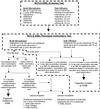Characterization of clinical isolates of Klebsiella pneumoniae from 19 laboratories using the National Committee for Clinical Laboratory Standards extended-spectrum beta-lactamase detection methods
- PMID: 11474005
- PMCID: PMC88252
- DOI: 10.1128/JCM.39.8.2864-2872.2001
Characterization of clinical isolates of Klebsiella pneumoniae from 19 laboratories using the National Committee for Clinical Laboratory Standards extended-spectrum beta-lactamase detection methods
Abstract
Extended-spectrum beta-lactamases (ESBLs) are enzymes found in gram-negative bacilli that mediate resistance to extended-spectrum cephalosporins and aztreonam. In 1999, the National Committee for Clinical Laboratory Standards (NCCLS) published methods for screening and confirming the presence of ESBLs in Klebsiella pneumoniae, Klebsiella oxytoca, and Escherichia coli. To evaluate the confirmation protocol, we tested 139 isolates of K. pneumoniae that were sent to Project ICARE (Intensive Care Antimicrobial Resistance Epidemiology) from 19 hospitals in 11 U.S. states. Each isolate met the NCCLS screening criteria for potential ESBL producers (ceftazidime [CAZ] or cefotaxime [CTX] MICs were > or =2 microg/ml for all isolates). Initially, 117 (84%) isolates demonstrated a clavulanic acid (CA) effect by disk diffusion (i.e., an increase in CAZ or CTX zone diameters of > or =5 mm in the presence of CA), and 114 (82%) demonstrated a CA effect by broth microdilution (reduction of CAZ or CTX MICs by > or =3 dilutions). For five isolates, a CA effect could not be determined initially by broth microdilution because of off-scale CAZ results. However, a CA effect was observed in two of these isolates by testing cefepime and cefepime plus CA. The cefoxitin MICs for 23 isolates that failed to show a CA effect by broth microdilution were > or =32 microg/ml, suggesting either the presence of an AmpC-type beta-lactamase or porin changes that could mask a CA effect. By isoelectric focusing (IEF), 7 of the 23 isolates contained a beta-lactamase with a pI of > or =8.3 suggestive of an AmpC-type beta-lactamase; 6 of the 7 isolates were shown by PCR to contain both ampC-type and bla(OXA) genes. The IEF profiles of the remaining 16 isolates showed a variety of beta-lactamase bands, all of which had pIs of < or =7.5. All 16 isolates were negative by PCR with multiple primer sets for ampC-type, bla(OXA), and bla(CTX-M) genes. In summary, 83.5% of the K. pneumoniae isolates that were identified initially as presumptive ESBL producers were positive for a CA effect, while 5.0% contained beta-lactamases that likely masked the CA effect. The remaining 11.5% of the isolates studied contained beta-lactamases that did not demonstrate a CA effect. An algorithm based on phenotypic analyses is suggested for evaluation of such isolates.
Figures
Similar articles
-
Evaluation of the NCCLS extended-spectrum beta-lactamase confirmation methods for Escherichia coli with isolates collected during Project ICARE.J Clin Microbiol. 2003 Jul;41(7):3142-6. doi: 10.1128/JCM.41.7.3142-3146.2003. J Clin Microbiol. 2003. PMID: 12843054 Free PMC article.
-
Laboratory identification, risk factors, and clinical outcomes of patients with bacteremia due to Escherichia coli and Klebsiella pneumoniae producing extended-spectrum and AmpC type β-lactamases.J Microbiol Immunol Infect. 2012 Jun;45(3):193-9. doi: 10.1016/j.jmii.2011.11.003. Epub 2012 May 12. J Microbiol Immunol Infect. 2012. PMID: 22580086
-
Phenotypic characteristics of clinical isolates of Klebsiella pneumoniae & evaluation of available phenotypic techniques for detection of extended spectrum beta-lactamases.Indian J Med Res. 2005 Oct;122(4):330-7. Indian J Med Res. 2005. PMID: 16394326
-
Towards a phenotypic screening strategy for emerging β-lactamases in Gram-negative bacilli.Int J Antimicrob Agents. 2013 Feb;41(2):99-109. doi: 10.1016/j.ijantimicag.2012.07.006. Epub 2012 Dec 29. Int J Antimicrob Agents. 2013. PMID: 23280443 Review.
-
Diagnosis and treatment of extended-spectrum and AmpC beta-lactamase-producing organisms.Ann Pharmacother. 2007 Sep;41(9):1427-35. doi: 10.1345/aph.1K213. Epub 2007 Jul 31. Ann Pharmacother. 2007. PMID: 17666573 Free PMC article. Review.
Cited by
-
Extended-spectrum beta-lactamase-producing Shigella strains in Israel, 2000-2004.Eur J Clin Microbiol Infect Dis. 2007 Mar;26(3):189-94. doi: 10.1007/s10096-007-0263-y. Eur J Clin Microbiol Infect Dis. 2007. PMID: 17265070
-
Evaluation of the new VITEK 2 extended-spectrum beta-lactamase (ESBL) test for rapid detection of ESBL production in Enterobacteriaceae isolates.J Clin Microbiol. 2006 Sep;44(9):3257-62. doi: 10.1128/JCM.00433-06. J Clin Microbiol. 2006. PMID: 16954257 Free PMC article.
-
Extended spectrum beta-lactamase (ESBL)-producing Enterobacteriaceae: considerations for diagnosis, prevention and drug treatment.Drugs. 2003;63(4):353-65. doi: 10.2165/00003495-200363040-00002. Drugs. 2003. PMID: 12558458 Review.
-
Identification of plasmid-mediated AmpC beta-lactamases in Escherichia coli, Klebsiella spp., and proteus species can potentially improve reporting of cephalosporin susceptibility testing results.J Clin Microbiol. 2009 Feb;47(2):294-9. doi: 10.1128/JCM.01797-08. Epub 2008 Nov 26. J Clin Microbiol. 2009. PMID: 19036936 Free PMC article.
-
Molecular characterization of extended-spectrum β-lactamases among clinical isolates of Escherichia coli & Klebsiella pneumoniae: A multi-centric study from tertiary care hospitals in India.Indian J Med Res. 2019 Feb;149(2):208-215. doi: 10.4103/ijmr.IJMR_172_18. Indian J Med Res. 2019. PMID: 31219085 Free PMC article.
References
-
- Archibald L, Phillips L, Monnet D, McGowan J E, Jr, Tenover F, Gaynes R. Antimicrobial resistance in isolates from inpatients and outpatients in the United States: the increasing importance of the intensive care unit. Clin Infect Dis. 1997;24:211–215. - PubMed
-
- Ardanuy C, Liñares J, Angeles Dominguez M, Hernández-Alléz S, Benedi V J, Martinez-Martinez L. Outer membrane profiles of clonally related Klebsiella pneumoniae isolates from clinical samples and activities of cephalosporins and carbapenems. Antimicrob Agents Chemother. 1998;42:1636–1640. - PMC - PubMed
-
- Bonomo R A, Rice L B. Inhibitor resistant class A beta-lactamases. Front Biosci. 1999;4:34–41. - PubMed
Publication types
MeSH terms
Substances
LinkOut - more resources
Full Text Sources
Medical
Research Materials
Miscellaneous




